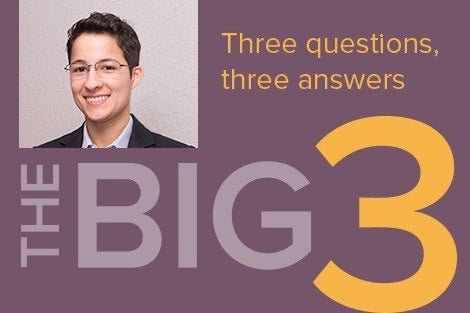April 16, 2018—Andrea Quiñones-Rivera, MPH ’18, co-authored a Viewpoint article published online February 26, 2018 in JAMA Internal Medicine describing the challenges faced by Puerto Rican medical students following last September’s storm.
What are some of the challenges that Puerto Rican medical students are facing?
Many didn’t have electricity, so they couldn’t use their computers to study, and when they could study it was in 90-degree weather. There was no internet or cellular communications, so they couldn’t communicate with their families, schools, and residency programs. This went on for months.
Medical student must pass certain benchmarks to progress through medical school, including school exams, national board exams, and applications for residencies. Their performance on these benchmarks affects their careers, and after the hurricane they were working under impossible conditions.
In addition, most medical students spent down their financial reserves. Student loans cover educational expenses and the cost of living for a normal year. After Hurricane Maria, 2017 was not a normal year. Students had to use their loan reserves to pay for emergency needs like water, food, fuel for their cars, generators, things for their families. Many found themselves without a safety net after these essential unexpected expenses.
And they, of course, face many other emotional and logistical challenges from surviving the disaster.
There are stories of students sleeping in the halls of their medical schools for weeks because they lost their homes. Some students lost family members. But despite these very challenging circumstances, students are rallying, and using their energy and resources to help people in their communities. Even after the storm, students have been selfless.
What is the Latino Medical Student Association doing to help?
The Latino Medical Student Association represents Latino medical students from across the United States, and a fair number of us are Puerto Rican. We had been hearing stories about Puerto Rican medical students who were really struggling, so another student and I reached out to see what we could do to help.
Our task force was able to provide grants for emergency funding to students whose financial safety nets had been exhausted. Now, we are opening a new cycle of grants to help students pay for board exams, which are very expensive. We’ve also sent out letters to residency programs, making sure that people know that Puerto Rican students are not international students. They are American medical students who graduate from United States LCME-accredited institutions.
What can be done to help mitigate problems for medical students following future disasters?
After Hurricane Katrina, medical schools stepped up to support students from their peer medical schools. We wish that the same had been true in the case of Puerto Rican medical students after Hurricane Maria but, simply put, these students did not receive the support they needed from mainland medicals schools and national medical organizations.
Medical schools have to see a disaster like this as something that can happen to them and their students anywhere at any time. They have the responsibility to push each other, and organizations like the American Association of Medical Colleges to ensure that the careers that medical students have been building for years are not jeopardized by a single storm, earthquake, or wildfire.
And when disasters do happen, medical schools have the responsibility to listen to their students, and to act to protect them. This can come in the form of an emergency fund for students and centralized systems that can facilitate the re-location of students. Schools also have a responsibility to support their low-income students and students who are underrepresented in medicine, who often have fewer resources to protect their education through events like this. In an era of increasing and increasingly severe natural disasters, medical schools should be ready to help each other and their trainees.
